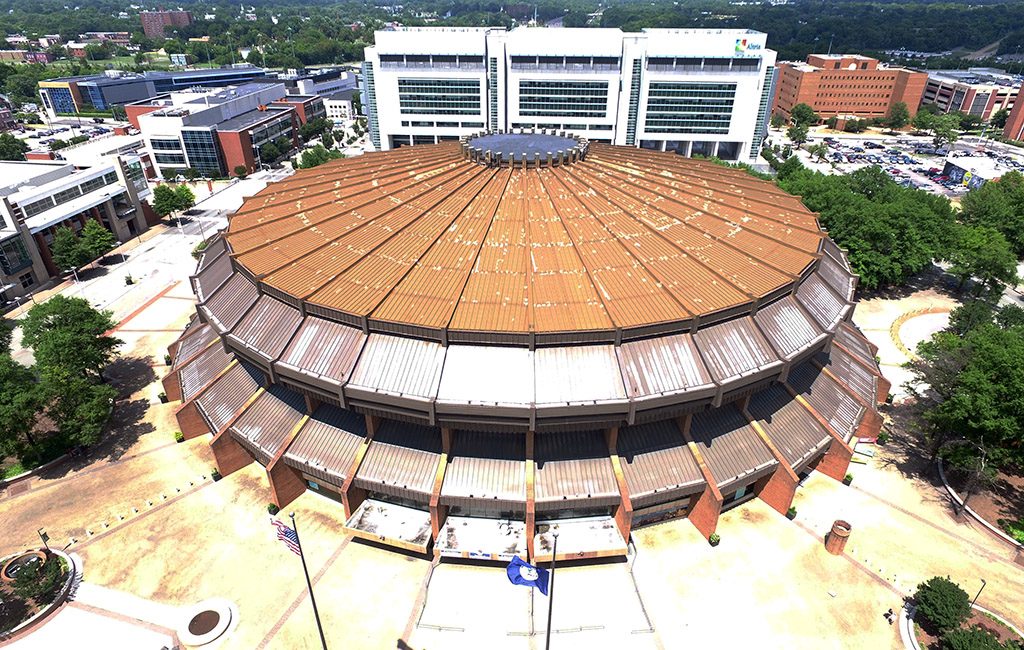As the fate of one proposal to redevelop the Richmond Coliseum and surrounding area remains in apparent limbo, a local developer is offering an alternate pitch to reinvigorate the 10-block swath of downtown.
Documents submitted last month to City Hall by Josh Bilder of Richmond-based Sterling Bilder LLC envision a $150 million to $270 million redevelopment that would retain the aging arena and incorporate it into the project, rather than demolishing and replacing it as proposed by NH District Corp., the Tom Farrell-led group that was the sole respondent to a request for proposals that the city put out a year ago.
While it’s unclear whether Bilder’s proposal could be considered or put into contention at this point, it does appear to offer an alternative to NH District Corp.’s $1.4 billion proposal, which received the endorsement of Mayor Levar Stoney in November but remains in negotiations and has yet to be presented to Richmond City Council.
In a letter dated Jan. 21 and sent to the city along with his proposal, Bilder makes the case for his plan, which he describes as “more creative and inclusive” than the alternative and allowing for public involvement – such as that sought by council when it voted in December to form an advisory commission to review NH District Corp.’s proposal once presented.
“I think something more creative and inclusive can be developed that will include the general public instead of … what is being proposed,” Bilder’s letter reads.
Reached Thursday, Bilder, whose projects in Richmond include the East End Theater and Patrick Square redevelopments in Church Hill, said he had approached the city about redeveloping the Coliseum area before the RFP was put out in late 2017.
“I felt like the city could do better than what was proposed by NH. That’s not to say that there’s anything wrong with their proposal. I’m not against it in any way,” he said. “But I felt like there could be a better way to approach the project.”
While he acknowledged he did not respond to the RFP directly, Bilder said he believes this latest proposal should be given consideration in light of his prior pitch.
“Since I had already submitted something initially, I felt like I could still submit something and have it considered,” Bilder said.
Jim Nolan, press secretary for the mayor, said in a statement that Bilder’s proposal falls short of the project both in timing and in meeting the requirements of the RFP.
“This proposal not only circumvents the RFP process by being submitted a year late, but would have fallen significantly short of meeting the requirements of the RFP had it been submitted by the due date,” Nolan said.
Coliseum would remain
Dubbed Navy Hill Yards, Bilder’s project would call for rehabbing the recently shuttered Coliseum and adding onto the exterior with a new structure that would encircle it with residential, hotel or office uses. The proposal cites the Barclays Center in New York City as an example.
“Sterling Bilder feels that rather (than) tearing the entire structure down that a renovation of the Coliseum with additional seating would be more cost effective for the development,” the proposal reads.
The Blues Armory would be turned into a hotel, apartments, offices or a combo of all three. Additional residential structures would be built to the east, with a mix of apartments, including market-rate units, and workforce and housing choice voucher units.
Bilder compares Navy Hill Yards to Chelsea Piers in Manhattan, with a mix of uses anchored by a sports and entertainment complex with retail, sports and fitness uses, including a skating rink, golf club and bowling alley. The former Sixth Street Marketplace atrium would be removed to create a pathway from Sixth Street and connectivity with Broad Street.
Sterling Bilder would purchase the properties from the city in what it proposes as a fee simple, arm’s-length transaction, with the purchase price assuming remaining debt left on the Coliseum and former Sixth Street Marketplace. Sterling Bilder would renegotiate the debt into a new financing package and pay off outstanding notes and liens, according to the proposal.
To address the city’s school improvement needs, the proposal also suggests a scenario in which Sterling Bilder would work with the city on a for-profit school management company that would use historic preservation tax credits to renovate and rehab historic school structures in Richmond.
For schools that don’t qualify, Sterling Bilder would sell credits to investors and use the proceeds to finance construction of new schools if a rehab is cost-prohibitive. Other renovations would be financed through the issuance of industrial development bonds with financial backing from the city, the proposal states.
Sterling Bilder breaks down the overall cost of the project at about $158 million for the Coliseum rehab and additions, $8 million for the Blues Armory, $17 million for the new residential structures, $50 million for Navy Hill Yards amenities and as much as $30 million for infrastructure improvements.
The proposal projects more than 10,000 new full- and part-time jobs would be generated from the development and school-management company, and it emphasizes working with local and minority contractors. It projects a one- to two-year construction schedule once agreements with the city are ironed out. The proposal includes renderings, including one from architecture firm Hickok Cole, which Bilder hired in early 2017 to do a conceptualization of the Blues Armory.
Offer already on the table
By comparison, NH District Corp.’s proposal calls for a renovated Blues Armory, a new-construction anchor hotel for the Greater Richmond Convention Center, mixed-income and affordable housing, a new bus transfer station, local job creation and a tax-increment financing (TIF) plan that backers say would have no moral or general obligation to the city.
Grant Neely, an NH District Corp. representative and Dominion Energy spokesman, said Thursday that negotiations between the group and the city are ongoing. He said the group did not have any comment about the Sterling Bilder proposal, which he said he had not seen and was not aware of.

Farrell discussed the project area at a meeting with area commercial real estate brokers last month. (Jonathan Spiers)
Farrell, CEO of Dominion Energy, has said the NH District Corp. proposal would meet all of the city’s RFP requirements, including creation of 9,000 permanent jobs and 12,500 construction jobs, with $300 million in contracts to be set aside specifically for minority-owned businesses, a 527-room Hyatt Regency-brand hotel and 680 income-based housing units that would add to 2,520 market-rate apartments.
Plans also call for replacing the GRTC transfer center along Ninth Street; new build-to-suit office buildings, one of which Farrell said has a commitment from VCU; and putting a 20,000-square-foot food court, 900-seat music hall and a ballroom in the armory.
The $1.4 billion investment would be funded in large part through the establishment of a TIF district, in which real estate tax revenue from new development in the district would be used specifically to pay for the project.
Plans call for the TIF district to cover areas beyond the 10-block project area, spanning a chunk of downtown bordered to the west and east by First and 10th streets and to the north and south by Interstate 64-95 and the Downtown Expressway. The expanded area includes the new Dominion tower under construction on South Sixth Street and the site of a planned second tower nearby.
The group has retained Fairfax-based Concord Eastridge and CEO Susan Eastridge, along with Michael Hallmark and his Los Angeles-based Future Cities, as master developers of the project through an entity called Capital City Partners.
‘I know this market, I know the city’
As a locally based developer, Bilder said he would bring a different perspective and personal investment to the project.
“What happens in the city affects me,” he said. “I live here, I work here, I pay taxes here. I’m not an out-of-town company that just wants to grab some money and leave. Everything I do is here.
“I feel like I know this market, I know the city,” he said. “I’ve worked successfully with the city, the state and the federal government. I’m confident that I could put the pieces together to make this thing work.”
While he acknowledged he has not taken on a project comparable in scope and budget to his Navy Hill Yards proposal, Bilder said he has a proven track record and is confident he can pull off his project.
“I haven’t done that size, but that’s not to say that the whole entire project needs to be done at once,” Bilder said. “What I’ve done in the East End and Church Hill has been in phases. I think the market is something that needs to be absorbed with large-scale projects like this. A lot of this could be public-private partnerships. I’m not opposed to bringing in consultants; I’m not opposed to working with other companies.
“I’m not trying to take anything away from anybody, but I think there is an opportunity to vet the plans – my plan and the others – and I think it’s important enough to reconsider some other ideas before the city enters into a huge project where a lot is on the line.”
As the fate of one proposal to redevelop the Richmond Coliseum and surrounding area remains in apparent limbo, a local developer is offering an alternate pitch to reinvigorate the 10-block swath of downtown.
Documents submitted last month to City Hall by Josh Bilder of Richmond-based Sterling Bilder LLC envision a $150 million to $270 million redevelopment that would retain the aging arena and incorporate it into the project, rather than demolishing and replacing it as proposed by NH District Corp., the Tom Farrell-led group that was the sole respondent to a request for proposals that the city put out a year ago.
While it’s unclear whether Bilder’s proposal could be considered or put into contention at this point, it does appear to offer an alternative to NH District Corp.’s $1.4 billion proposal, which received the endorsement of Mayor Levar Stoney in November but remains in negotiations and has yet to be presented to Richmond City Council.
In a letter dated Jan. 21 and sent to the city along with his proposal, Bilder makes the case for his plan, which he describes as “more creative and inclusive” than the alternative and allowing for public involvement – such as that sought by council when it voted in December to form an advisory commission to review NH District Corp.’s proposal once presented.
“I think something more creative and inclusive can be developed that will include the general public instead of … what is being proposed,” Bilder’s letter reads.
Reached Thursday, Bilder, whose projects in Richmond include the East End Theater and Patrick Square redevelopments in Church Hill, said he had approached the city about redeveloping the Coliseum area before the RFP was put out in late 2017.
“I felt like the city could do better than what was proposed by NH. That’s not to say that there’s anything wrong with their proposal. I’m not against it in any way,” he said. “But I felt like there could be a better way to approach the project.”
While he acknowledged he did not respond to the RFP directly, Bilder said he believes this latest proposal should be given consideration in light of his prior pitch.
“Since I had already submitted something initially, I felt like I could still submit something and have it considered,” Bilder said.
Jim Nolan, press secretary for the mayor, said in a statement that Bilder’s proposal falls short of the project both in timing and in meeting the requirements of the RFP.
“This proposal not only circumvents the RFP process by being submitted a year late, but would have fallen significantly short of meeting the requirements of the RFP had it been submitted by the due date,” Nolan said.
Coliseum would remain
Dubbed Navy Hill Yards, Bilder’s project would call for rehabbing the recently shuttered Coliseum and adding onto the exterior with a new structure that would encircle it with residential, hotel or office uses. The proposal cites the Barclays Center in New York City as an example.
“Sterling Bilder feels that rather (than) tearing the entire structure down that a renovation of the Coliseum with additional seating would be more cost effective for the development,” the proposal reads.
The Blues Armory would be turned into a hotel, apartments, offices or a combo of all three. Additional residential structures would be built to the east, with a mix of apartments, including market-rate units, and workforce and housing choice voucher units.
Bilder compares Navy Hill Yards to Chelsea Piers in Manhattan, with a mix of uses anchored by a sports and entertainment complex with retail, sports and fitness uses, including a skating rink, golf club and bowling alley. The former Sixth Street Marketplace atrium would be removed to create a pathway from Sixth Street and connectivity with Broad Street.
Sterling Bilder would purchase the properties from the city in what it proposes as a fee simple, arm’s-length transaction, with the purchase price assuming remaining debt left on the Coliseum and former Sixth Street Marketplace. Sterling Bilder would renegotiate the debt into a new financing package and pay off outstanding notes and liens, according to the proposal.
To address the city’s school improvement needs, the proposal also suggests a scenario in which Sterling Bilder would work with the city on a for-profit school management company that would use historic preservation tax credits to renovate and rehab historic school structures in Richmond.
For schools that don’t qualify, Sterling Bilder would sell credits to investors and use the proceeds to finance construction of new schools if a rehab is cost-prohibitive. Other renovations would be financed through the issuance of industrial development bonds with financial backing from the city, the proposal states.
Sterling Bilder breaks down the overall cost of the project at about $158 million for the Coliseum rehab and additions, $8 million for the Blues Armory, $17 million for the new residential structures, $50 million for Navy Hill Yards amenities and as much as $30 million for infrastructure improvements.
The proposal projects more than 10,000 new full- and part-time jobs would be generated from the development and school-management company, and it emphasizes working with local and minority contractors. It projects a one- to two-year construction schedule once agreements with the city are ironed out. The proposal includes renderings, including one from architecture firm Hickok Cole, which Bilder hired in early 2017 to do a conceptualization of the Blues Armory.
Offer already on the table
By comparison, NH District Corp.’s proposal calls for a renovated Blues Armory, a new-construction anchor hotel for the Greater Richmond Convention Center, mixed-income and affordable housing, a new bus transfer station, local job creation and a tax-increment financing (TIF) plan that backers say would have no moral or general obligation to the city.
Grant Neely, an NH District Corp. representative and Dominion Energy spokesman, said Thursday that negotiations between the group and the city are ongoing. He said the group did not have any comment about the Sterling Bilder proposal, which he said he had not seen and was not aware of.

Farrell discussed the project area at a meeting with area commercial real estate brokers last month. (Jonathan Spiers)
Farrell, CEO of Dominion Energy, has said the NH District Corp. proposal would meet all of the city’s RFP requirements, including creation of 9,000 permanent jobs and 12,500 construction jobs, with $300 million in contracts to be set aside specifically for minority-owned businesses, a 527-room Hyatt Regency-brand hotel and 680 income-based housing units that would add to 2,520 market-rate apartments.
Plans also call for replacing the GRTC transfer center along Ninth Street; new build-to-suit office buildings, one of which Farrell said has a commitment from VCU; and putting a 20,000-square-foot food court, 900-seat music hall and a ballroom in the armory.
The $1.4 billion investment would be funded in large part through the establishment of a TIF district, in which real estate tax revenue from new development in the district would be used specifically to pay for the project.
Plans call for the TIF district to cover areas beyond the 10-block project area, spanning a chunk of downtown bordered to the west and east by First and 10th streets and to the north and south by Interstate 64-95 and the Downtown Expressway. The expanded area includes the new Dominion tower under construction on South Sixth Street and the site of a planned second tower nearby.
The group has retained Fairfax-based Concord Eastridge and CEO Susan Eastridge, along with Michael Hallmark and his Los Angeles-based Future Cities, as master developers of the project through an entity called Capital City Partners.
‘I know this market, I know the city’
As a locally based developer, Bilder said he would bring a different perspective and personal investment to the project.
“What happens in the city affects me,” he said. “I live here, I work here, I pay taxes here. I’m not an out-of-town company that just wants to grab some money and leave. Everything I do is here.
“I feel like I know this market, I know the city,” he said. “I’ve worked successfully with the city, the state and the federal government. I’m confident that I could put the pieces together to make this thing work.”
While he acknowledged he has not taken on a project comparable in scope and budget to his Navy Hill Yards proposal, Bilder said he has a proven track record and is confident he can pull off his project.
“I haven’t done that size, but that’s not to say that the whole entire project needs to be done at once,” Bilder said. “What I’ve done in the East End and Church Hill has been in phases. I think the market is something that needs to be absorbed with large-scale projects like this. A lot of this could be public-private partnerships. I’m not opposed to bringing in consultants; I’m not opposed to working with other companies.
“I’m not trying to take anything away from anybody, but I think there is an opportunity to vet the plans – my plan and the others – and I think it’s important enough to reconsider some other ideas before the city enters into a huge project where a lot is on the line.”







A noble attempt to show the City we can achieve our goal with less. Personally, I think Bilder has some not very positive history with his work in Church Hill, so I’d say next developer please. The red flag is the attempt to purchase this land from the City. I appreciate the transparency, but if we’re selling this land then it needs a fair market process or we’re likely to get shafted.
No matter what, it is clear – taxpayers are the fish, developers and politicians are the sharks.
I’m tired of out of state (or even out of country) developers coming in and ruining the Richmond landscape. I think renovating and keeping the Coliseum is the best option, and if Bilder is offering that to the community then it should be evaluated. Let’s take a look a the ‘Luxury Apartments’ being built over the old SunTrust on Broad St, and the Short-Pump(esque) addition to the top of Cary Street. Do we really want all this? Let’s preserve Richmond, yall.
Kate;
More people are coming to the Richmond area, and the choice is to build “out” or “up”. Building out tears up the country side and leads to more traffic and pollution, and less greenspace. Building up, having higher density in already built up area, will lead to more walkable areas served by mass transit.
My only problem with Short Pump is that it was built where there were farms. If it had been put over some sites that were dead urban retail spaces we’d be much better off.
Ed, you do realize that the retailers will follow the money, don’t you? Short Pump Regional Mall was built where it is because it is in the confluence of I-64, I-288, I-295, between two of the biggest employment centers in central Virginia (Innsbrook and West Creek) and smack dab in the middle of the wealthiest housing concentration in the Commonwealth south of the Rappahannock River. And Kate, while I support you on your “up, not out” because you make a great point, nearly all the significant office buildings downtown (including the Federal Reserve) were built with funds from outside our… Read more »
Bruce;
I don’t think i made my point very clearly, I was using “Short Pump” to encompass the general development in the area.
We could have left green space and built up in other areas, like we are now doing in Scott’s Addition, and Scotts 2.0.
I agree with Ashley and I think the fair option is to reissue the RFP with a 6-month reply window since the NHs current attempt is as dead as the downtown ballpark Jones never put before Council. I will also add that it is funny that our Coliseum is old, dilapidated, and functionally obsolete but Hampton Coliseum, the Berglund (Roanoke Civic) Center, and Norfolk Scope, all built during the same time period as the Richmond Coliseum, are still active and used for large events. No Beyoncé and Maroon5 type shows but look at JPJs website through June…..no huge national acts… Read more »
Why would anyone want to rehab a functionally obsolete building, that is undersized, and ugly for $158 million? It still wouldn’t be able to compete with JPJ in Charlottesville , Va. , which seats 16,000 vs. 13,553 for the Coliseum. Furthermore acts at the Coliseum have to bring everything up to the main floor using 1 freight elevator. At JPJ there are several loading dock at the ground level. Freight elevators aren’t required. That’s what happens when you build from the ground up! I would also predict that the cost will exceed any estimates, which is customary when you undertake… Read more »
And new construction never has runs over budget; especially when it involves a non-profit funded through our fair City. Thanks for the BELLY laugh Brian. The last time the City estimated streetscape work for the Broad CDA they could not work on parking deck rehab/build outs because the $25 million streetscape estimate turned into $67 million in work. The City has NO idea what is under its streets. Plus so detailed, clean and well done is the proposal that a year after the finished version was submitted NOTHING has been put before Council for a vote. Sources in City Hall… Read more »